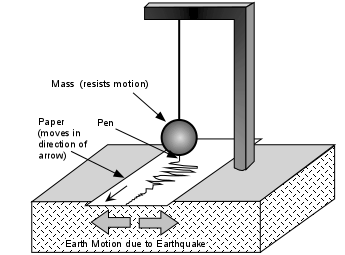

 |
 |
|
From early times, human curiosity about the world has stimulated attempts to make measurements of natural events. Insights into the attributes acnd even the causes of natural phenomena hinge on such quantitative representations. In the case of the earthquakes, the phenomenon which is to be represented is the movement of the ground. A seismometer is the instrument used to record the seismic waves that travel through the Earth as vibrations. The resulting graph that shows the vibrations is called a seismograph. The basic mechanical principle in a seismometer is that it has to parts, one of which move with the ground vibrations, and the other one remains nearly stationary. The relative motion between the two parts through time is a measure of the ground displacement or wave amplitude. |

Basic seismometer: The frame moves with the ground, while the heavy mass resists motion. Their relative motion is printed as a seismogram. |
Thus a basic seismometer would be constructed by freely suspending a large mass from a frame attached to the ground; thanks to its inertia, the mass is reasonably independent of the frame's motion. When the frame is shaken by earthquake waves, the inertia of the mass causes it to lag behind the motion of the frame. In the classical instrument before the coming of digital displays, this relative motion was recorded by pen and ink on paper wrapped around a rotating drum, or by a light spot of on film, producing the familiar record known as a seimogram. |
|
Today, earthquakes are not recorded straight onto paper, they are turned into an electric signal first. The earth's movements are picked up through a small coil attached to the pendulum, which swings between the poles of a magnet mounted on a support. As the coil moves through the magnetic field, an electric current is generated, and since electric currents are easy to control, the signal can be conveniently amplified or reduced depending on what size earthquakes you want to record. During an earthquake, the ground moves simultaneously in three dimensions: for example, up-down, east-west and north-south. A single seismograph records only one of these three components of motion. To complete record the motion at a point it is possible to combine records from three separate seismographs, one for each component of the motion. Seismometers also have different frequency sensitivity depending on the pendulum's length or the spring's elasticity. When the shaking ground moves back and forth at frequencies much smaller than the natural frequency of the pendulum, the displacement of the pendulum's mass relative to the frame closely follows the acceleration of the ground. Although the ground acceleration is useful information for structural engineers, seismologists often prefer their seismographs to measure ground displacement rather than acceleration. If the seismic wave frequencies approach the pendulum's natural frequency, the mass does not move much at all. In that case, the relative displacement between the pendulum and the frame can be amplified to give a true measure of the displacement of the seismic waves. Traditionally, observatories operate a number of seismographs designed with varied sensitivity to the frequencies in an earthquake, which range from 1 mHz to more than 10 Hz. Seismographs often must record waves with amplitudes as small as 1 nm, the size of a molecule of gas. To be seen, this amplitude has to be magnified. In modern seismographs, the relative motion between the pendulum and frame produces an electric signal that is magnified electronically thousands and even hundreds of thousands of time before it is used to drive an electic stylus writing on sensitive paper. The electric signal from a seismograph pendulum can also be recorded onto magnetic tape or stored as a series of numbers in a computer. This heigh resolution of modern seismometers allow geologists to detect earthquakes located far away from their seismic station. This is called remote sensing. Modern seismographs record the ground motion uninterruptedly, and they contain clock devices that continuously provide the time. It is thus possible to measure, with high fidelity, the wavelenghts and amplitudes of the waves. Moreover, nowadays most seismic station around the world are connected with each other in an unrestricted global surveillance, continuously interchanging data in real time. With all the recordings that can be collected thanks to this huge network, it is possible to undertake a systematic analysis of eartquake patterns. |